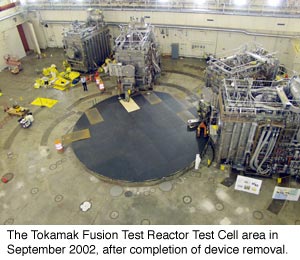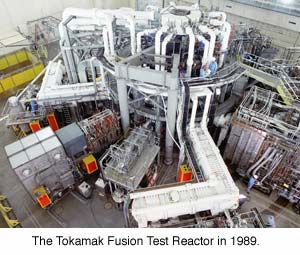
21 October 2002

21 October 2002
(To download print-quality photo files of the Tokamak Fusion Test Reactor Test Cell area before and after device removal go to the end of this article.)

Plainsboro, New Jersey -- One of the world's largest and most successful experimental fusion machines has been safely disassembled and cleared away. In September, staff at the U.S. Department of Energy's (DOE) Princeton Plasma Physics Laboratory (PPPL) completed the dismantling and removal of the Tokamak Fusion Test Reactor (TFTR), which shut down in 1997 following 15 years of operation. During its experimental life, TFTR set records for fusion performance and made major contributions to the development of fusion as a long-term energy alternative. The PPPL team finished the removal of TFTR on schedule and under budget.
"This marks the end of an important chapter in the history of fusion," said Raymond L. Orbach, Director of the Office of Science, which oversees PPPL for the U.S. Department of Energy. "The Tokamak Fusion Test Reactor achieved many firsts that brought us closer to an era of fusion power. Now that the decommissioning of TFTR has been completed safely, on schedule and under budget, in keeping with Office of Science best practices, we look forward to continued contributions in fusion power research from PPPL."
PPPL Director Robert J. Goldston noted, "The unprecedented scientific success of TFTR experiments has now been followed by its safe dismantling and removal. Not only did TFTR greatly advance fusion science, but its safe, cost-effective, and efficient decommissioning also demonstrates the promise of fusion as an environmentally attractive, economical energy source."
TFTR was the world's first magnetic fusion device to perform extensive scientific experiments with plasmas composed of 50/50 deuterium/tritium (D-T), the fuel mix required for practical fusion power production, and also the first to produce more than 10 million watts of fusion power. In 1995, TFTR attained a world-record temperature of 510 million degrees centigrade -- more than 25 times that at the center of the sun.
Since the completion of D-T experiments on TFTR in 1997, PPPL has focused on nurturing the best new ideas in fusion research, both in advanced tokamaks and in innovative confinement configurations. Two major experimental projects, along with increased theory and computation, will anchor this program. The first, the National Spherical Torus Experiment (NSTX), is already producing an increased understanding of fusion physics. The second, the National Compact Stellarator Experiment (NCSX), now being designed, will provide further insight into the capabilities of stellarators, particularly for stable, continuous operation.

Work on the removal of TFTR began in October of 1999. The experiment stood 24-feet tall with a diameter of 38 feet. It contained an 80-ton doughnut-shaped vacuum chamber, 587 tons of magnetic field coils, a 15-ton titanium center column, and a massive stainless-steel support structure. TFTR's use of a fuel mixture containing tritium, a mildly radioactive form of hydrogen, added to the challenge of its safe and environmentally sound removal.
The most challenging aspect of the TFTR disassembly was the segmentation of the 100-cubic-yard vacuum vessel. Use of conventional technologies such as abrasive sawing and flame cutting could not satisfy health and safety concerns. PPPL's engineering team effectively addressed all challenges by developing an innovative system -- Diamond Wire Cutting used in conjunction with a concrete filling technique -- which reduced worker radiation exposure, airborne emissions, and waste generation. PPPL's unique and innovative application of Diamond Wire Cutting earned the Laboratory the New Jersey Society of Professional Engineers' 2002 Outstanding Engineering Achievement Award.
In the fusion process, matter is converted to energy when the nuclei of light elements, such as hydrogen, join or fuse to form heavier elements. In experiments such as TFTR, physicists employ magnetic fields to confine hot, ionized gases called plasmas, which fuel the fusion reactions. Compared to fossil fuels and fission, now used in commercial power plants, fusion would have distinct advantages, including an inexhaustible fuel supply; no chemical combustion products; and inherent safety, with minimal production of waste.
PPPL, funded by the U.S. Department of Energy and managed by Princeton University, is a collaborative national center for science and innovation leading to an attractive fusion energy source. The Laboratory is on Princeton's James Forrestal Campus, off U.S. Route 1 in Plainsboro, NJ.
For further information, please contact:
Anthony R. DeMeo
Head
Information Services
Princeton Plasma Physics Laboratory
(609) 243-2755
ademeo@pppl.gov
Patricia Wieser
Information Services
Princeton Plasma Physics Laboratory
(609) 243-2757
pwieser@pppl.gov
To download print-quality photos, click on a link below. When the large photo appears in your browser, click and hold down the mouse. When the dialogue box appears, make the appropriate selection.
Downloadable print-quality photo of The Tokamak Fusion Test Reactor Device in 1989. Resolution is 300 dpi, print size is approximately 6.6 inches wide by 5 inches high, file type is jpeg, and file size is 4.0 MB. Photo by Dietmar Krause and John Peoples, PPPL.
Downloadable print-quality photo of The Tokamak Fusion Test Reactor Test Cell area in September 2002, after completion of device removal. Resolution is 300 dpi, print size is approximately 6.6 inches wide by 5 inches high, file type is jpeg, and file size is 3.4 MB. Photo by Elle Starkman, PPPL.